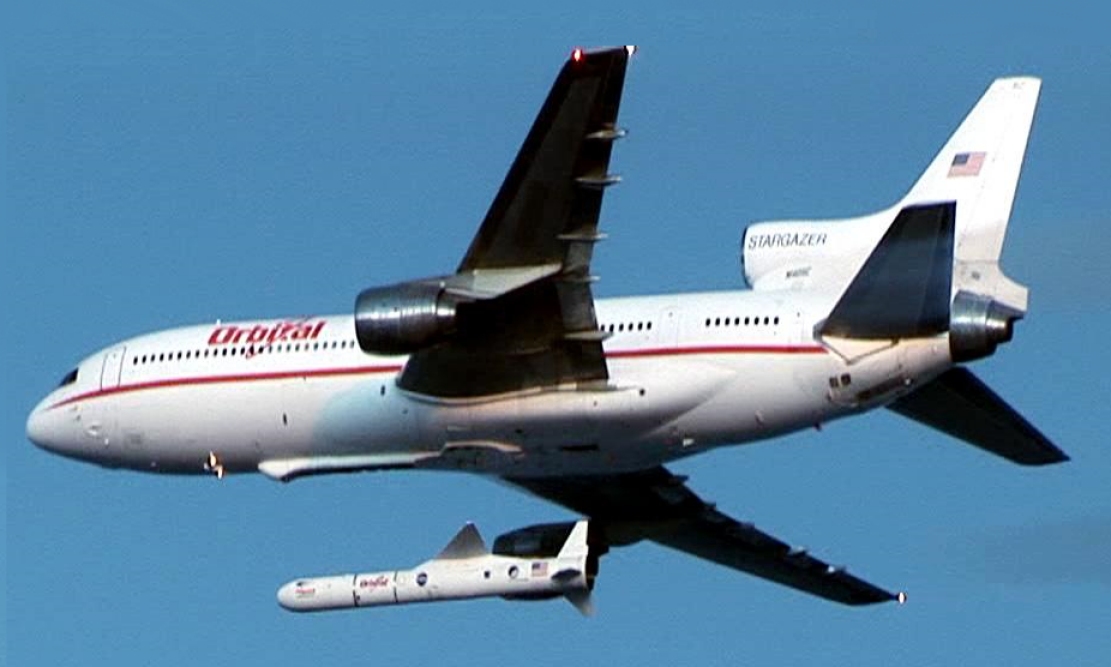
Pegasus
In-activeOrbital Sciences Corporation (OSC)
April 5, 1990
Description
The Pegasus is an air-launched rocket developed by Orbital Sciences Corporation (now part of Northrop Grumman Innovation Systems). Capable of carrying small payloads of up to 443 kilograms (977 lb) into low Earth orbit, the vehicle consists of three solid propellant stages and an optional monopropellant fourth stage. Pegasus is released from its carrier aircraft at approximately 40,000 ft (12,000 m), and its first stage has a wing and a tail to provide lift and attitude control while in the atmosphere.
Specifications
-
Stages
3 -
Length
16.9 m -
Diameter
1.27 m -
Fairing Diameter
― -
Launch Mass
18 T -
Thrust
580 kN -
Apogee (Sub-Orbital)
4000 km
Family
-
Name
Pegasus -
Family
― -
Variant
― -
Alias
― -
Full Name
Pegasus
Payload Capacity
-
Launch Cost
$40000000 -
Low Earth Orbit
443 kg -
Geostationary Transfer
Orbit
― -
Direct Geostationary
― -
Sun-Synchronous Capacity
―
Orbital Sciences Corporation
Commercial
None
OSCNone
Pegasus | APEX
Orbital Sciences Corporation | United States of AmericaAir launch to orbit
Aug. 3, 1994, 2:38 p.m.
Status: Launch Successful
Mission:
APEX (Advanced Photovoltaic & Electronic Experiment) successfully tested a wide array of advanced photovoltaic and electronic components in a harsh radiation environment, provided significant data to support improved designs for future space systems. During operation, APEX's highly elliptical orbit allowed the investigation of space plasma effects on high-voltage operation (current leakage at positive voltages and arcing at negative voltages) in the perigee region, plus the investigation of space radiation effects (decreased array power output from passage through the inner radiation belt) in the apogee region.
Elliptical OrbitPegasus | Array of Low Energy X-ray Imaging Sensors (ALEXIS)
Orbital Sciences Corporation | United States of AmericaAir launch to orbit
April 25, 1993, 1:56 p.m.
Pegasus | Satélite de Coleta de Dados-1 (SCD-1)
Orbital Sciences Corporation | United States of AmericaAir launch to orbit
Feb. 9, 1993, 2:30 p.m.
Long March 5
Chang'e 6
101 - Wenchang Space Launch Site, People's Republic of ChinaChang'e 6/CE-6 is scheduled to launch in 2024 to return samples from the Far Side of the Moon (near southern edge of the Apollo Basin) for the first …
SR75
Maiden Flight
Pad 1 - Koonibba Test Range, South AustraliaTest flight of HyImpulse's SR75 sounding rocket
Falcon 9
Starlink Group 6-55
Space Launch Complex 40 - Cape Canaveral, FL, USAA batch of 23 satellites for the Starlink mega-constellation - SpaceX's project for space-based Internet communication system.
Falcon 9
WorldView Legion 1 & 2
Space Launch Complex 4E - Vandenberg SFB, CA, USAWorldView Legion is a constellation of Earth observation satellites built and operated by Maxar. Constellation is planned to consist of 6 satellites …
Falcon 9
Starlink Group 6-54
Space Launch Complex 40 - Cape Canaveral, FL, USAA batch of 23 satellites for the Starlink mega-constellation - SpaceX's project for space-based Internet communication system.

